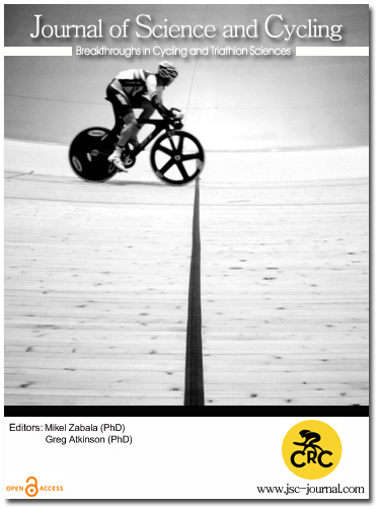Effects of Horizontal Saddle Displacement on Energy Expenditure of Mountain Bike Cyclists. A Pilot Study
DOI:
https://doi.org/10.28985/1324.jsc.09Keywords:
Saddle Position, Mountain Bike, Energy Expenditure, PerformanceAbstract
The process of optimizing the cyclist-bicycle relationship has been referred to as fundamental for optimizing cyclist performance. In the published literature, studies are scarce to understand and make decisions about the consequences of changing the saddle position in mountain bike cyclists. The main objective of this study was to determine the performance implications resulting from changing the position of a mountain bike cyclist's saddle through its horizontal displacement, in relation to the reference position obtained by traditional methods. The experimental design of this study consisted of a cross-sectional, randomized experimental study, where submaximal tests were conducted in laboratory on six high-level mountain bike cyclists. Six saddle positions in flat and uphill simulation were tested and the horizontal displacement of the saddle was related to the variables oxygen consumption, lactate concentration, heart rate and rate of perceived exertion. The results demonstrated that, as the saddle is moved horizontally towards the handlebars, oxygen consumption and blood lactate concentration values decrease. There were no significant differences in the mean values for heart rate and rate of perceived exertion. However, there were significant differences between participants regarding all variables under study in all saddle positions. In conclusion, the results suggest that the horizontal variation of a mountain bike cyclist's saddle has an impact on oxygen consumption, lactate concentration, heart rate and rate of perceived exertion and, consequently, on performance. The results also seem to suggest that horizontal displacement of the saddle position towards forward positions in the direction of the handlebars has benefits for the cyclist by reducing energy consumption and, when determining the ideal position of the saddle, the cyclist’s individual characteristics must be considered.
Downloads
Published
How to Cite
Issue
Section
Copyright (c) 2024 Journal of Science and Cycling

This work is licensed under a Creative Commons Attribution-NonCommercial-NoDerivatives 4.0 International License.
Authors contributing to Journal of Science and Cycling agree to publish their articles under a Creative Commons CC BY-NC-ND license, allowing third parties to copy and redistribute the material in any medium or format, and to remix, transform, and build upon the material, for any purpose, even commercially, under the condition that appropriate credit is given, that a link to the license is provided, and that you indicate if changes were made. You may do so in any reasonable manner, but not in any way that suggests the licensor endorses you or your use.
Authors retain copyright of their work, with first publication rights granted to Cycling Research Center.






